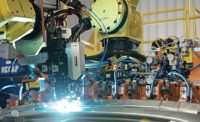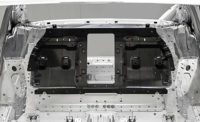“What is particularly interesting about the demand for lightweight materials in commercial vehicle applications are the motivations behind it,” says Marc Purslow, arc welding applications engineer at EWI. “With passenger vehicles, the push for weight savings is driven by a need to increase fuel economy and reduce emissions. With commercial vehicles, the motivation is based more on the cargo-carrying capacity of the vehicle.
“Simply put, each pound saved in the weight of the vehicle will allow the user to carry an additional pound of cargo,” Purslow points out. “These pounds can add up, making weight savings an effective way for commercial vehicle manufacturers to gain a competitive advantage by increasing the cargo-carrying capacity of their vehicles.”
One way that truck manufacturers can effectively reduce weight while circumventing some of the challenges associated with higher-strength or dissimilar materials is through intelligent design using current materials. For instance, Purslow and his EWI colleagues typically apply their expertise in materials, numerical modeling and design of welded structures to optimize manufacturers’ designs, often starting with a design review meeting.
Aluminum is an easy way to achieve big reductions in big-rig weight. A number of welding processes can be used for joining aluminum components and sheets, such as spot welding, gas tungsten arc welding, gas metal arc welding and laser welding. However, engineers must be careful when working with aluminum.
“Welding aluminum is significantly more difficult than welding steel, as it requires a greater degree of skill,” warns Purslow. “Part preparation and cleanliness are critical variables.
“Common issues when welding aluminum are lack of fusion, lack of penetration and porosity,” claims Purslow. “Many aluminum alloys are considered to be nonweldable using arc-welding processes, since they are prone to solidification cracking and may have an increased susceptibility to stress corrosion cracking.”
Aluminum is also particularly prone to distortion issues when joining with fusion welding processes. “While a reduction in heat input and weld size can minimize distortion, it can be a significant issue when welding thin sheet to more rigid components,” says Purslow. “As a result, aluminum sheet is often mechanically fastened. The down-side of mechanical fastening is that it typically has a detrimental effect on productivity, and can lead to unfavorable stress concentrations at the location of the fasteners.”
Purslow believes that optimizing currently-used welding processes for minimal heat-input can be an effective method of addressing the distortion problem. This can be accomplished through the use of lower heat-input processes or increased travel speeds. Solid-state processes, such as friction-stir spot welding, can also provide many of the benefits of welding without the detrimental distortion effects.
Carbon-fiber is another lightweight alternative that’s gaining popularity with truck manufacturers. However, the material cannot be joined using traditional fusion-based arc welding processes.
“While research has been conducted on the joining of carbon fiber using solid-state welding processes, it is most commonly joined by bonding or mechanical fastening,” says Purslow. “Precautions must be taken into consideration when using mechanical fastening, such as aluminum or steel inserts at the location of the bolt hole.
“The issue which most commonly limits the use of carbon-fiber components is cost,” adds Purslow. “While manufacturers are finding applications which maximize its impact, the high cost of these materials can often outweigh their benefits, especially for low-volume components.”



